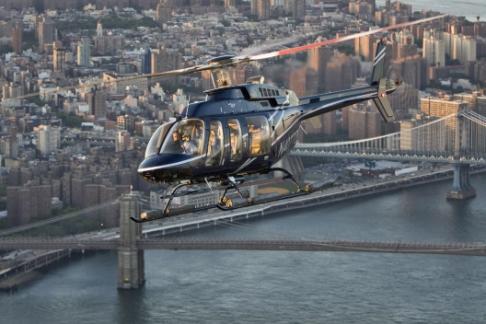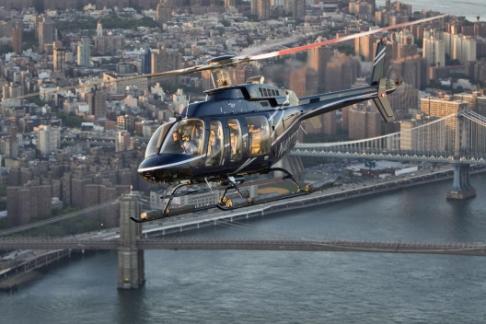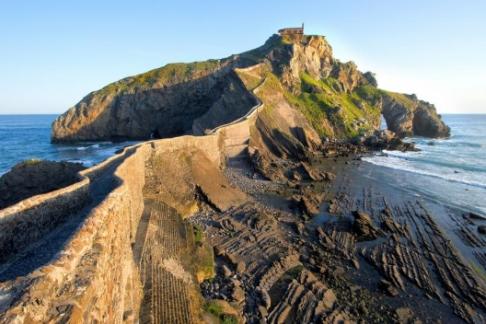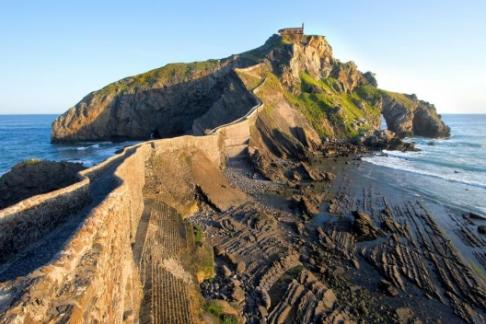
Helicopter Flight Services - The Ultimate Tour + 9/11 Memorial Museum
OverView
Helicopter Flight Services - The Ultimate Tour
Helicopter Flight Services is proud to operate top-of-the-line, high-performance Bell407 (up to 6 pax) and EC130 (up to 7 pax) helicopters. The spacious cabins and high visibility windows have been specially designed for sightseeing which allows 180 degree views; no other helicopter operator in New York City can offer these unobstructed views. The Bell and EC130 have proven to be safe, fast and powerful helicopters giving an incredibly smooth ride in virtually all conditions. Pilots are specially trained on both types of helicopters and the state-of-the-art safety system, TCAS. TCAS is an onboard radar system that allows pilots the advantage of managing the air traffic around them. All passengers enjoy their flight with voice interactive headsets to hear and speak to the pilot and each other.
Basque Coast: Biosphere of Urdaibai, Bermeo & Gernika
LANGUAGES: English and Spanish The tour begins at 09:00 am from the center of Bilbao to direct us along the right bank of the river and leaving the other side of the estuary the industrial towns of Barakaldo, Sestao and Portugalete. Once in Getxo, we reach the famous Hanging Bridge, where we make a brief stop for who wants to climb on it from above has breathtaking views magnificence cas. We travel to pass through the imposing Castle Butron with 45 meters high and Mungia. From here we head for the coast to San Juan de Gaztelugatxe, beautiful chapel clinging to a rock and surrounded by the sea. We will continue along the coast to the typical fishing village of Bermeo, where we stop to visit. Then get up the coast to Mundaka, where we can enjoy its beauty and magnificence cas delight with views of the Biosphere Reserve of Urdaibai. We followed the trail to reach the emblematic town of Gernika and visit its famous Opera House and Tree Boards. Back to Bilbao Bizkaia inside with beautiful scenery and return to your hotel about 14:00
Jungle Island - General Admission
Discover one of the best things to do in Miami! Minutes from South Beach, Miami Beach and Downtown Miami, Jungle Island enriches the lives of park visitors through immersive experiences centered on adventure, animals, discovery and play. Discover Jungle Island today! Shows Jungle Island’s three entertaining shows feature some of the wildest animals from around the globe. From the world’s most lethal bird-Cassowary to some of the most amazing animals you will have to see to believe. *schedule subject to change Winged Wonders Times: Daily 13:00 & 16:30 Location: Parrot Bowl Presented in the Coca-Cola Parrot Bowl, Winged Wonders captivates audiences with some of the most beautiful, playful, and dangerous birds from all over the world. Come soar with us and discover some of the world’s most fascinating birds including our very own Andean condor, beautiful stunt-performing macaws, and many other amazing feathered friends. Wild Encounter Times: Daily 11:00 & 14:30 Location: Jungle Theater Wild Encounter will enchant you with some fascinating felines.Don’t miss this exciting presentation of some of the jungle’s most respected animals. This incredible presentation of big cats is produced by T.I.G.E.R.S., The Institute of Greatly Endangered and Rare Species, an international big cat conservation educational organization. After each show, guests can purchase special, upclose photographs with tiger cubs or primates. Wild Adventures Times: Daily 12:00 & 15:30 Location: Serpentarium While Doctor Wasabi is out on safari, come visit with our animal care staff as we unlock the secrets behind some of the jungle's most rare and unusual residents. Exhibits Posing Area Smile! And don’t forget to take a famous picture with one of our beautiful and colorful parrots. Parrot Cove Times: Daily 11:00 to 17:00 Located at the farthest tip of Jungle Island, Parrot Cove is Miami’s only private beach. This sophisticated tropical beach playground offers breathtaking views of Biscayne Bay and downtown Miami and is exclusively for the use of park guests. After getting up-close to some of the world’s most fascinating animals, park guests can head to Parrot Cove for more adventures under the sun. At this beach oasis located at the tip of Jungle Island, visitors can relax in lounge chairs and then cool off by wading into Biscayne Bay. With the cost of admission to Jungle Island, the entrance fee to Parrot Cove is free. Be sure to stop by Parrot Cove to stay cool and relaxed in between Jungle Island's fascinating animal shows. Manu Encounter Times: Daily 11:00 to 17:00 Location: Manu Fashioned after the clay cliffs in Manu, Peru. This is an interactive experience with Squirrel Monkeys, free-flying macaws and parrots as well as other exotic animals. A brief presentation on the habits and habitats of these animals will be given by one of our Animal Care Trainers who will remain present to answer questions relating to this exhibit. Orangutan School Times: Daily 13:10 Location: Primadomes Witness the tremendous intelligence of our outstanding orangutans as they go back to school. Kangaroo Konnection Times: Daily 11:30 - 16:00 Location: Kangaroo Paddock Come meet and interact with our cuddly Kangaroos! Petting Barn Times: 10:30 - 17:00 Location: Petting Barn by Children's Playground Come pet and feed our petting barn animals. Makes for a wonderful memory and some wonderful pictures! Everglades Habitat & Walk Make your way across a true replica of the Florida Everglades, complete with beautiful flora and fauna from the region. Feed our birds around the park Many of our magnificent birds enjoy being fed by you, our guests. You’ll find them along our jungle paths with food dispensers at each location. Interact with Trainers and Animals As you wander through the park, you’ll encounter our trainers who host an assortment of animals. Touch, ask questions, and make friends. Penguin Exhibit Times: See penguins after each Wild Adventures Show Location: Serpentarium Our South African penguins are so adorable. Come see our fluffy little friends swim and waddle around their penguin pool. Playground It’s your time to monkey around. Frolic on slides and crawl tubes. Tortoise Exhibit You’ll be astonished at the size of these giant tortoises. Some males grow to 500 pounds and can live for 150 years.
BridgeClimb Sydney - BridgeClimb at Night
The price can vary according to visit date and time selected. Night This climb departs after the sun has set (after “twilight”), introducing the city alight and sparkling under a blanket of darkness. 5 Things you need to know before your climb Health & Safety Your health and safety is important: If you are pregnant or have any pre-existing health conditions you may need to provide a doctor’s Certificate of Fitness note before you climb. You must have a blood-alcohol reading below 0.05 to climb (the same as if you are driving). You will be asked to complete a BridgeClimb Declaration Form before your Climb. Please be honest about your health so we can ensure your wellbeing is not at risk. All discussions will be confidential. Preparations How should you prepare for your Climb: Ensure that you have eaten before your Climb and you’re well-hydrated – the experience can last up to 3 ½ hours. Wear comfortable, enclosed rubber-soled shoes such as running, sport or hiking shoes and don’t forget your sunglasses. It is recommend to wear comfortable clothing. You will be equipped with everything else you need for your Climb! Ensure you arrive 15 minutes before your scheduled Climb time to allow enough time to check in. Personal Belongings All your personal belongings can be stored in lockers, including cameras: there are FREE secure lockers for you to keep your personal belongings in, including phones, cameras and GoPros. The Climb Leaders will capture photos of you during your Climb. For safety and security reasons, cameras, video technology and mobile devices are prohibited on the Climb. Restrictions You must be 8 years old and 1.2 metres in height, or taller: Children aged 8 to 15 must be accompanied by and are the responsibility of an adult, with a maximum of three children per adult. Weather Conditions Climbs operate in all weather conditions: You will equipped with all the gear you need to keep you dry, but remember to bring your own shoes, which should be enclosed, like running shoes. In case of extreme weather conditions like electrical storms or during times of extremely high wind, Climbs may be postponed.
Vitoria & Rioja Wine Area
LANGUAGES: English and Spanish The tour begins at 09:00 am from the center of Bilbao to Vitoria go directly toward the highway. The tour shows the mountain scenery until reaching the plateau with its forests of oak and beech. Arriving in Vitoria embark on a panoramic city tour through the entire modern urban design. Then stop in the Old Quarter of the city to visit and have free time to walk its streets, its old town, or a coffee in one of its many bars. From here, we go through different towns in Alava until finally arriving at Laguardia and Labastida, famous people of the Rioja Alavesa by a Historic Monument and also its magnificent wineries. We have time to walk its medieval streets, stately houses and two fortified churches. Free time for lunch at one of its typical restaurants, and our guide will offer details of restaurants and menus chosen. In addition, visiting a winery to taste their wines. Direct return to Bilbao by highway and return to your hotel mid-afternoon.
Black Canyon River Adventures - Black Canyon Raft Tour
Box Lunch Including: Turkey wrap, fruit, cookies, chips and bottled water in an insulated, souvenir cooler. Also available: Vegetarian and Gluten free lunches (48 hour notice required). Three hours are spent exploring 12-miles of history, beauty and wonder as you glide through the Black Canyon National Water Trail, with walls that in some places tower 2,000 feet above the river’s edge. Experience the waterfalls, hot springs and other geological wonders, the Desert Big Horn sheep, Osprey, Great Blue Heron and so much more. This trip is fully narrated by experienced, knowledgeable guides who offer incredible knowledge of the history of the Hoover Dam and the Black Canyon National Water trail. Lunch is included in a take-home, insulated souvenir bag. A refreshing stop along the way at a side beach will give you the opportunity to stretch your legs and to swim or play in the cool clear water of the Colorado River. Your tour will end at the Willow Beach Marina in the scenic Mohave desert of Arizona, where you will board your shuttle back to where you started from. ~Don’t Forget Your Camera~






